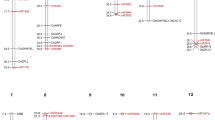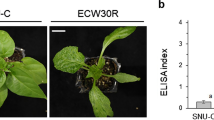Abstract.
In this study, we collected and analyzed DNA sequence data for 789 previously mapped RFLP probes from Sorghum bicolor (L.) Moench. DNA sequences, comprising 894 non-redundant contigs and end sequences, were searched against three GenBank databases, nucleotide (nt), protein (nr) and EST (dbEST), using BLAST algorithms. Matching ESTs were also searched against nt and nr. Translated DNA sequences were then searched against the conserved domain database (CDD) to determine if functional domains/motifs were congruent with the proteins identified in previous searches. More than half (500/894 or 56%) of the query sequences had significant matches in at least one of the GenBank searches. Overall, proteins identified for 148 sequences (17%) were consistent among all searches, of which 66 sequences (7%) contained congruent coding domains. The RFLP probe sequences were also evaluated for the presence of simple sequence repeats (SSRs) and 60 SSRs were developed and assayed in an array of sorghum germplasm comprising inbreds, landraces and wild relatives. Overall, these SSR loci had lower levels of polymorphism (D = 0.46, averaged over 51 polymorphic loci) compared with sorghum SSRs that were isolated by library hybridization screens (D = 0.69, averaged over 38 polymorphic loci). This result was probably due to the relatively small proportion of di-nucleotide repeat-containing markers (42% of the total SSR loci) obtained from the DNA sequence data. These di-nucleotide markers also contained shorter repeat motifs than those isolated from genomic libraries. Based on BLAST results, 24 SSRs (40%) were located within, or near, previously annotated or hypothetical genes. We determined the location of 19 of these SSRs relative to putative coding regions. In general, SSRs located in coding regions were less polymorphic (D = 0.07, averaged over three loci) than those from gene flanking regions, UTRs and introns (D = 0.49, averaged over 16 loci). The sequence information and SSR loci generated through this study will be valuable for application to sorghum genetics and improvement, including gene discovery, marker-assisted selection, diversity and pedigree analyses, comparative mapping and evolutionary genetic studies.
Similar content being viewed by others
Author information
Authors and Affiliations
Additional information
Electronic Publication
Rights and permissions
About this article
Cite this article
Schloss, .S., Mitchell, .S., White, .G. et al. Characterization of RFLP probe sequences for gene discovery and SSR development in Sorghum bicolor (L.) Moench. Theor Appl Genet 105, 912–920 (2002). https://doi.org/10.1007/s00122-002-0991-4
Received:
Accepted:
Issue Date:
DOI: https://doi.org/10.1007/s00122-002-0991-4




